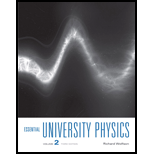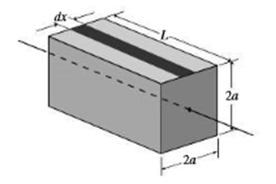
Essential University Physics: Volume 2 (3rd Edition)
3rd Edition
ISBN: 9780321976420
Author: Richard Wolfson
Publisher: PEARSON
expand_more
expand_more
format_list_bulleted
Concept explainers
Textbook Question
Chapter 21, Problem 68P
Figure 21.37 shows a rectangular box with sides 2a and length L surrounding a line carrying uniform line charge density A. The line passes directly through the center of the box faces. Integrate the field of the line charge over strips of width dx as shown to find the electric flux through one face of the box. Multiply by 4 to get the total flux, and show that your result is consistent with Gauss’s law.

FIGURE 21.37 Problem 68
Expert Solution & Answer
Want to see the full answer?
Check out a sample textbook solution
Students have asked these similar questions
Phys 25
Phys 22
Phys #20
Chapter 21 Solutions
Essential University Physics: Volume 2 (3rd Edition)
Ch. 21.1 - Which figure represents the electric field of a...Ch. 21.2 - The figure shows a cube of side s in a uniform...Ch. 21.3 - A spherical surface surrounds an isolated positive...Ch. 21.4 - A spherical shell carries charge Q distributed...Ch. 21.5 - (1) If you're close to a finite line of charge...Ch. 21.6 - (1) If you're close to a finite line of charge...Ch. 21 - Can electric field lines ever cross? Why or why...Ch. 21 - The electric flux through a closed surface is...Ch. 21 - If the flux of the gravitational field through a...Ch. 21 - Under what conditions can the electric flux...
Ch. 21 - Right field lines emerge from a closed surface...Ch. 21 - If a charged particle were released from rest on a...Ch. 21 - In Gausss law, EdA=q0does the field E necessarily...Ch. 21 - In a certain region the electric field points to...Ch. 21 - A point charge is located a fixed distance outside...Ch. 21 - The field of an infinite charged line decreases as...Ch. 21 - Why cant you use Gausss law to determine the field...Ch. 21 - Youre sitting inside an uncharged, hollow...Ch. 21 - Does Gausss law apply to a spherical Gaussian...Ch. 21 - An insulating sphere carries charge spread...Ch. 21 - Why must the electric field be zero inside a...Ch. 21 - The electric field of a flat sheet of charge is...Ch. 21 - In Fig. 21.32, the magnitude of the middle charge...Ch. 21 - Charges +2q and q are near each other. Sketch some...Ch. 21 - The net charge shown in Fig. 21.33 is +Q. Identify...Ch. 21 - A flat surface with area 2.0 m2 is in a uniform...Ch. 21 - Whats the electric field strength in a region...Ch. 21 - A flat surface with area 0.14 m2 lies in the x-y...Ch. 21 - The electric field on the surface of a...Ch. 21 - In the figure with GOT IT? 21.2, take E = 1.75...Ch. 21 - In Fig. 21.8, take the half-cylinders radius and...Ch. 21 - A sock comes out of the dryer with a trillion...Ch. 21 - Whats the electric flux through the closed...Ch. 21 - Interpret This problem involves applying Gauss's...Ch. 21 - A 2.6-C charge is at the center of a cube 7.5 cm...Ch. 21 - The electric field at the surface of a...Ch. 21 - A solid sphere 25 cm in radius carries 14C,...Ch. 21 - A 15-nC point charge is at the center of a thin...Ch. 21 - The electric field strength outside a charge...Ch. 21 - An electron close to a large, Hat sheet of charge...Ch. 21 - Find the field produced by a uniformly charged...Ch. 21 - What surface charge density on an infinite sheet...Ch. 21 - A rod 50 cm long and 1.0 cm in radius carries a...Ch. 21 - Whats the approximate field strength 1 cm above a...Ch. 21 - The disk in Fig. 21.22 has area 0.14 m2 and is...Ch. 21 - What is the electric field strength just outside...Ch. 21 - A net charge of 5.0 C is applied on one side of a...Ch. 21 - A positive point charge q lies at the center of a...Ch. 21 - A total charge of 18 C is applied to a thin,...Ch. 21 - Whats the flux through the hemispherical open...Ch. 21 - An electric field is given byE=E0(y/a)k, where E0...Ch. 21 - The electric field in a certain region is given by...Ch. 21 - A study shows that mammalian red blood cells...Ch. 21 - Positive charge is spread uniformly over the...Ch. 21 - A solid sphere 2.0 cm in radius carries a uniform...Ch. 21 - A point charge of 2Q is at the center of a...Ch. 21 - A friend is working on a biology experiment and...Ch. 21 - A spherical shell of radius 15 cm carries 4.8 C...Ch. 21 - A spherical shell 30 cm in diameter carries 85 C...Ch. 21 - A thick, spherical shell of inner radius a and...Ch. 21 - A long, thin wire carrying 5.6 nC/m runs down the...Ch. 21 - An infinitely long rod of radius R carries a...Ch. 21 - A long, solid rod 4.5 cm in radius carries a...Ch. 21 - If you painted positive charge on the floor, what...Ch. 21 - A charged slab extends infinitely in two...Ch. 21 - A solid sphere 10 cm in radius carries a 40-C...Ch. 21 - A nonconducting square plate 75 cm on a side...Ch. 21 - A 250-nC point charge is placed at the center of...Ch. 21 - An irregular conductor containing an irregular,...Ch. 21 - You measure the electric field strength at points...Ch. 21 - A point charge q is at the center of a spherical...Ch. 21 - A point charge q is at the center of a spherical...Ch. 21 - The volume charge density inside a solid sphere of...Ch. 21 - Figure 21.37 shows a rectangular box with sides 2a...Ch. 21 - The charge density within a charged sphere of...Ch. 21 - Calculate the electric fields in Example 21.2...Ch. 21 - A solid sphere of radius R carries a nonuniform...Ch. 21 - Problem 76 of Chapter 13 explored what happened to...Ch. 21 - An infinitely long solid cylinder of radius R...Ch. 21 - A solid sphere of radius R carries a uniform...Ch. 21 - Repeal Problem 59 for the case where the charge...Ch. 21 - Coaxial cables are widely used with audio-visual...Ch. 21 - A coaxial cable carries equal but opposite charges...Ch. 21 - How does the electric field between the conductors...Ch. 21 - Coaxial cables are widely used with audio-visual...
Additional Science Textbook Solutions
Find more solutions based on key concepts
MAKE CONNECTIONS In Concept 20.2, you learned about genome-wide association studies. Explain how these studies...
Campbell Biology (11th Edition)
Draw the following orbitals: a. 3s orbital b. 4s orbital c. 3p orbital
Organic Chemistry (8th Edition)
16. Explain some of the reasons why the human species has been able to expand in number and distribution to a g...
Campbell Biology: Concepts & Connections (9th Edition)
explain the function of fermentation and the conditions under which it occurs?
Biology: Life on Earth with Physiology (11th Edition)
Heat lamps are commonly used to maintain foods at about 50C for as long as 12 hours in cafeteria serving lines....
Microbiology: An Introduction
5. In a type of parakeet known as a “budgie,” feather color is controlled by two genes. A yellow pigment is syn...
Genetic Analysis: An Integrated Approach (3rd Edition)
Knowledge Booster
Learn more about
Need a deep-dive on the concept behind this application? Look no further. Learn more about this topic, physics and related others by exploring similar questions and additional content below.Similar questions
- Point charges q1 = 50 µC and q2 = −25 µC are placed 1.0 m apart. What is the magnitude of the force on a third charge q3 = 40 µC placed midway between q1 and q2? (The prefix µ =10−6 C.)arrow_forwardThe de-excitation of a state occurs by competing emission and relaxation processes. If the relaxation mechanisms are very effective:a) the emission of radiation is largeb) the emission of radiation is smallc) the emission occurs at a shorter wavelengthd) the de-excitation occurs only by emission processesarrow_forwardm C A block of mass m slides down a ramp of height hand collides with an identical block that is initially at rest. The two blocks stick together and travel around a loop of radius R without losing contact with the track. Point A is at the top of the loop, point B is at the end of a horizon- tal diameter, and point C is at the bottom of the loop, as shown in the figure above. Assume that friction between the track and blocks is negligible. (a) The dots below represent the two connected blocks at points A, B, and C. Draw free-body dia- grams showing and labeling the forces (not com ponents) exerted on the blocks at each position. Draw the relative lengths of all vectors to reflect the relative magnitude of the forces. Point A Point B Point C (b) For each of the following, derive an expression in terms of m, h, R, and fundamental constants. i. The speed of moving block at the bottom of the ramp, just before it contacts the stationary block ii. The speed of the two blocks immediately…arrow_forward
arrow_back_ios
SEE MORE QUESTIONS
arrow_forward_ios
Recommended textbooks for you
 Physics for Scientists and Engineers: Foundations...PhysicsISBN:9781133939146Author:Katz, Debora M.Publisher:Cengage Learning
Physics for Scientists and Engineers: Foundations...PhysicsISBN:9781133939146Author:Katz, Debora M.Publisher:Cengage Learning Principles of Physics: A Calculus-Based TextPhysicsISBN:9781133104261Author:Raymond A. Serway, John W. JewettPublisher:Cengage Learning
Principles of Physics: A Calculus-Based TextPhysicsISBN:9781133104261Author:Raymond A. Serway, John W. JewettPublisher:Cengage Learning Physics for Scientists and Engineers, Technology ...PhysicsISBN:9781305116399Author:Raymond A. Serway, John W. JewettPublisher:Cengage Learning
Physics for Scientists and Engineers, Technology ...PhysicsISBN:9781305116399Author:Raymond A. Serway, John W. JewettPublisher:Cengage Learning Physics for Scientists and EngineersPhysicsISBN:9781337553278Author:Raymond A. Serway, John W. JewettPublisher:Cengage Learning
Physics for Scientists and EngineersPhysicsISBN:9781337553278Author:Raymond A. Serway, John W. JewettPublisher:Cengage Learning Physics for Scientists and Engineers with Modern ...PhysicsISBN:9781337553292Author:Raymond A. Serway, John W. JewettPublisher:Cengage Learning
Physics for Scientists and Engineers with Modern ...PhysicsISBN:9781337553292Author:Raymond A. Serway, John W. JewettPublisher:Cengage Learning

Physics for Scientists and Engineers: Foundations...
Physics
ISBN:9781133939146
Author:Katz, Debora M.
Publisher:Cengage Learning

Principles of Physics: A Calculus-Based Text
Physics
ISBN:9781133104261
Author:Raymond A. Serway, John W. Jewett
Publisher:Cengage Learning

Physics for Scientists and Engineers, Technology ...
Physics
ISBN:9781305116399
Author:Raymond A. Serway, John W. Jewett
Publisher:Cengage Learning

Physics for Scientists and Engineers
Physics
ISBN:9781337553278
Author:Raymond A. Serway, John W. Jewett
Publisher:Cengage Learning

Physics for Scientists and Engineers with Modern ...
Physics
ISBN:9781337553292
Author:Raymond A. Serway, John W. Jewett
Publisher:Cengage Learning

Electric Fields: Crash Course Physics #26; Author: CrashCourse;https://www.youtube.com/watch?v=mdulzEfQXDE;License: Standard YouTube License, CC-BY